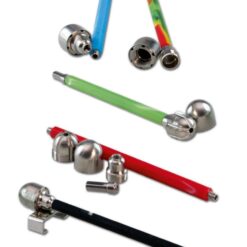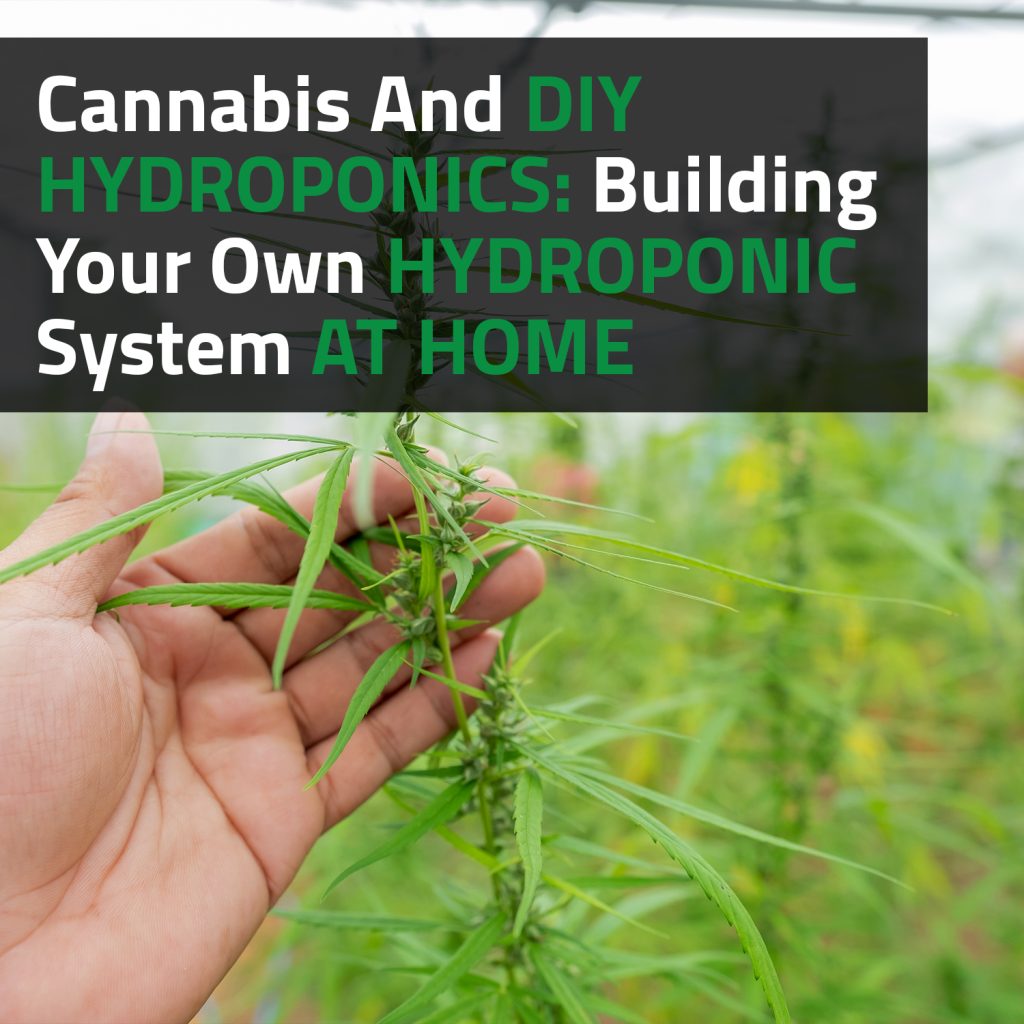In recent years, the cultivation of cannabis has undergone a transformative shift, with enthusiasts and cultivators increasingly turning to hydroponics as a cutting-edge method for maximising plant growth. Hydroponic systems, which involve growing plants without soil and instead utilising nutrient-rich water solutions, offer numerous advantages for cannabis cultivation, including faster growth rates, increased yields, and precise control over environmental factors.
This article delves into the intersection of cannabis cultivation and do-it-yourself (DIY) hydroponics, guiding enthusiasts through the process of building their own hydroponic systems at home. Whether you’re a seasoned cannabis grower or a curious beginner, this comprehensive guide explores the fundamentals of hydroponics, the essential components needed for a DIY setup, and provides step-by-step instructions to empower you on your journey to cultivate high-quality cannabis in the comfort of your own home.
Understanding The Basics: What Is Hydroponics?
Hydroponics, derived from the Greek words “hydro” (water) and “ponos” (labour), represents a revolutionary approach to plant cultivation by eliminating traditional soil in favour of nutrient-rich water solutions. This method provides a controlled environment that allows cultivators to precisely manage the key factors influencing plant growth. At its core, hydroponics leverages the direct delivery of essential nutrients to plant roots, bypassing the need for soil as a medium. This departure from conventional soil-based cultivation offers several advantages, including increased growth rates, enhanced nutrient absorption, and the ability to optimise environmental conditions.
In a hydroponic system, plants are typically housed in inert growing mediums like coconut coir, perlite, or rock wool, providing physical support while allowing for optimal root aeration. The nutrient solution, a carefully balanced mix of essential elements, is circulated around the roots to ensure a constant supply of nutrients. This precise control over nutrient intake enables plants to focus more energy on above-ground growth, resulting in faster and healthier development.
Hydroponic systems come in various forms, each with its unique set of advantages. The Nutrient Film Technique (NFT) involves a thin film of nutrient solution flowing over the plant roots, while Deep Water Culture (DWC) suspends plants in a nutrient-rich water reservoir. Ebb and Flow systems alternate between flooding the root zone with nutrient solution and allowing it to drain.
One of the primary benefits of hydroponics is the elimination of soil-borne diseases and pests, providing a cleaner and more controlled environment for plant growth. Additionally, hydroponic systems enable growers to fine-tune factors such as pH levels, ensuring that nutrient uptake remains optimal. As we delve deeper into DIY hydroponics for cannabis cultivation, a solid understanding of these basics will serve as a foundation for building and maintaining an efficient and productive home hydroponic system.
Essential Components For DIY Hydroponic Systems
Building your own hydroponic system at home requires careful consideration of essential components to ensure a successful and thriving cannabis cultivation environment. Each element plays a crucial role in providing the necessary support, nutrient delivery, and environmental control for your plants.
Growing Medium
Selecting an appropriate growing medium is pivotal in hydroponics. Common choices include coconut coir, perlite, vermiculite, or rock wool. These mediums provide physical support to the plants while allowing for proper aeration and nutrient absorption.
Reservoir
The reservoir holds the nutrient solution, acting as the central hub for delivering essential nutrients to the plants. Choose a reservoir size that accommodates the number of plants you intend to grow and consider materials that are durable and light-resistant to prevent algae growth.
Nutrient Solution
A well-balanced nutrient solution is critical for plant growth in hydroponic systems. Invest in a quality hydroponic nutrient mix that includes essential elements such as nitrogen, phosphorus, potassium, calcium, and magnesium. Follow the manufacturer’s guidelines for proper dilution and application.
pH Testing Kit And Adjusters
Maintaining the correct pH level is vital for nutrient absorption. A pH testing kit helps monitor the acidity or alkalinity of the nutrient solution. pH adjusters, usually in the form of pH up (alkaline) or pH down (acidic) solutions, allow you to fine-tune the pH levels as needed.
Water Pump
For systems that require nutrient circulation, a water pump is necessary. It ensures a consistent flow of nutrient solution to the plants. Choose a pump with an appropriate flow rate for the size of your system.
Tubing And Fittings
Tubing and fittings connect various components of your hydroponic system. Use durable and non-toxic materials to prevent contamination of the nutrient solution. Ensure that tubing sizes match the fittings to maintain a secure and leak-free system.
Air Pump And Air Stones (For DWC Systems)
Deep Water Culture (DWC) systems require adequate oxygenation for the plant roots. An air pump, along with air stones, introduces oxygen into the nutrient solution, promoting healthy root development.
Lighting System
While not specific to hydroponics, a proper lighting system is essential for cannabis cultivation. Choose high-quality grow lights that provide the necessary spectrum for different growth stages. LED or high-intensity discharge (HID) lights are popular choices for indoor hydroponic setups.
Containers Or Net Pots
Containers or net pots hold the plants and growing medium, allowing for easy insertion into the hydroponic system. Ensure they are durable, have good drainage, and are appropriately sized for the plants you are cultivating.
Timer
For systems with periodic nutrient delivery, a timer is essential. It controls the on/off cycles of the water pump, ensuring a consistent and timed supply of nutrient solution to the plants.
Choosing The Right Cannabis Strains For Hydroponic Cultivation
Selecting the appropriate cannabis strains is a pivotal decision when venturing into hydroponic cultivation. Different strains exhibit unique characteristics in terms of growth patterns, nutrient requirements, and overall adaptability to the controlled environment that hydroponics provides.
Indica Vs. Sativa Vs. Hybrid
Consider the predominant strain type that aligns with your preferences and cultivation goals. Indica strains are known for their compact stature, making them suitable for limited space. Sativa strains, on the other hand, tend to be taller with a more extended flowering time. Hybrid strains combine characteristics of both.
Size And Growth Characteristics
Assess the available space in your hydroponic system and choose strains that match the available vertical and horizontal space. Some strains are naturally compact and bushy, while others may stretch during the flowering phase.
Flowering Time
Understanding the flowering time of a cannabis strain is crucial for planning your cultivation cycle. Hydroponic systems often enable faster growth, but strains can still vary in their time to reach maturity. Choose strains with flowering periods that align with your desired harvest timeline.
Nutrient Sensitivity
Different cannabis strains may exhibit varying levels of sensitivity to nutrients. Some strains are more forgiving, making them suitable for growers who are still fine-tuning their nutrient management skills. Research the nutrient preferences of your chosen strains to optimise hydroponic feeding schedules.
Cannabinoid And Terpene Profiles
Consider the desired effects and flavours you seek in your cannabis. Different strains offer varying cannabinoid and terpene profiles, influencing the overall experience and medicinal benefits. Hydroponics can enhance the expression of these compounds, so choose strains that align with your preferences.
Disease Resistance
Hydroponic systems, while reducing the risk of soil-borne diseases, may still expose plants to certain challenges. Select cannabis strains known for their resilience and disease resistance, ensuring a healthier and more robust garden.
Climate And Environmental Considerations
Hydroponic systems allow for precise control over the growing environment. Choose strains that thrive in the temperature and humidity ranges you can maintain. Some strains may be better suited for indoor cultivation, while others may perform well in greenhouse setups.
Yield Potential
Assess the yield potential of different strains, considering your cultivation goals. Some strains may produce higher quantities of flowers, making them suitable for those seeking a substantial harvest.
Cultivation Experience
Consider your level of experience as a grower. Some strains are more forgiving of minor errors in cultivation practices, making them ideal for beginners. If you are more experienced, you may explore strains with specific challenges or unique characteristics.
Step-By-Step Guide: Building Your Own Hydroponic System
Embarking on the journey of building your own hydroponic system for cannabis cultivation requires careful planning and attention to detail. Follow this step-by-step guide to create an efficient and productive DIY hydroponic setup:
1. Define Your Space
Begin by identifying the space where you intend to set up your hydroponic system. Whether it’s a dedicated grow room, a closet, or a tent, ensure the area provides adequate ventilation, access to electricity, and sufficient space for the desired number of plants.
2. Choose A Hydroponic System Type
Select a hydroponic system that suits your space, budget, and cultivation goals. Options include Nutrient Film Technique (NFT), Deep Water Culture (DWC), Ebb and Flow, and others. Each system has its advantages, so choose based on your preferences and available resources.
3. Gather Essential Components
Assemble all the necessary components, including a growing medium, reservoir, nutrient solution, pH testing kit, water pump, tubing, air pump (for DWC systems), lighting system, containers or net pots, and a timer. Ensure the components are of high quality and suitable for the chosen hydroponic system.
4. Prepare The Growing Medium
If using a growing medium like coconut coir or rock wool, prepare it according to the manufacturer’s instructions. Ensure proper pH levels and sterilise the medium if necessary to prevent the introduction of contaminants.
5. Set Up The Reservoir
Place the reservoir in a location that is easily accessible for maintenance. Fill it with the recommended amount of water and add the appropriate quantity of hydroponic nutrient solution. Use a pH testing kit to check and adjust the pH level to the optimal range for cannabis cultivation.
6. Install The Water Pump And Tubing
If your hydroponic system requires a water pump for nutrient circulation, install it in the reservoir and connect the tubing. Ensure the tubing reaches each plant site or growing channel in your system.
7. Arrange Containers Or Net Pots
Position the containers or net pots within the hydroponic system, securing them in a way that provides stability for the plants. Place the growing medium and, if applicable, insert the cannabis seedlings or clones.
8. Set Up Lighting System
Install the lighting system above the plants, ensuring proper spacing and coverage. Adjust the height of the lights based on the growth stage of the plants, following the recommendations for the specific type of lights you’re using.
9. Integrate Air Pump And Stones (For DWC Systems)
If you’re using a Deep Water Culture (DWC) system, connect the air pump to air stones and place them in the reservoir. This helps oxygenate the nutrient solution and promotes healthy root development.
10. Implement A Timer
Set up a timer to control the on/off cycles of the water pump. This ensures a regular and consistent supply of nutrient solution to the plants, optimising their growth.
11. Monitor And Adjust
Regularly monitor the pH levels, nutrient concentration, and overall health of your plants. Make adjustments as needed to maintain optimal growing conditions. Keep a close eye on factors like temperature, humidity, and lighting to ensure a thriving hydroponic garden.
12. Harvest And Repeat
Once your cannabis plants have reached maturity, carefully harvest the flowers. Depending on your goals, you can then repeat the cultivation cycle, enjoying the benefits of a controlled and efficient hydroponic system.
In the realm of home cannabis cultivation, the marriage of hydroponics and do-it-yourself ingenuity opens a gateway to an exciting and rewarding journey. By understanding the fundamentals of hydroponics, carefully selecting suitable cannabis strains, and meticulously crafting your DIY hydroponic system, you embark on a path that promises faster growth, increased yields, and precise control over cultivation variables.
As you witness the vibrant growth and bountiful harvests facilitated by your own hydroponic setup, you not only cultivate cannabis but also cultivate a deeper connection with the fascinating world of plant science. With dedication, experimentation, and our tips for a green thumb, your home hydroponic cannabis garden becomes a testament to the potential that DIY cultivation holds, empowering enthusiasts to nurture nature’s bounty within the comfort of their own homes.
-
Crafty +
R5,500.00 -
DAVINCI IQ-C Vaporizer
R3,950.00 -
Volcano – HYBRID
R9,780.00 – R11,000.00 -
Black Leaf – “Wand Vape” Steel Hand Vaporizer
R375.00Original price was: R375.00.R185.00Current price is: R185.00.










